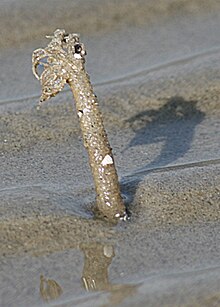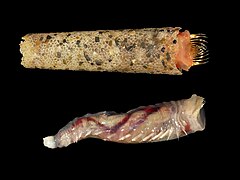Terebellida
| Terebellida | |
|---|---|

| |
| Cirriformia capensis (Cirratulidae) | |
| Scientific classification | |
| Domain: | Eukaryota |
| Kingdom: | Animalia |
| Phylum: | Annelida |
| Clade: | Pleistoannelida |
| Clade: | Sedentaria |
| Infraclass: | Canalipalpata |
| Order: | Terebellida |
| Families | |
|
Several, see text | |
Terebellida make up an
Systematics

Such structures can be preserved as fossils.
There is little consensus on the number of families. Some treatments accept as little as five,[2][3] while other authors list over a dozen. Here, the more inclusive view of the Terebellida is followed, based on a major review of polychaete systematics.[1] Cladistic studies have hitherto only analyzed a rather small proportion of polychaetes; hence it may be that some of the families today included in Terebellida by most authors will eventually be again recognized to belong elsewhere.
- Acrocirridae (acrocirrids, sometimes placed in Spionida suborder)
- Alvinellidae (alvinellids)
- Ampharetidae (ampharetids)
- Ampharetinae (ampharetines, a subfamily)
- Cirratulidae (cirratulids, sometimes placed in Spionida suborder)
- Ctenodrilidae (ctenodrilids, sometimes own suborder Ctenodrilida)
- Fauveliopsidae (fauveliopsids, sometimes own suborder Fauveliopsida)
- Flabelligeridae (flabelligerids, sometimes Flabelligerida suborder)
- Flotidae (flotids, sometimes included in Flabelligeridae)
- Pectinariidae (pectinariids, commonly referred to as trumpet worms or ice cream cone worms)
- Poeobiidae(poeobiids, sometimes own suborder Poeobiida or included in Flabelligerida suborder)
- Sternaspidae (sternaspids, sometimes own suborder Sternaspida)
- Terebellidae (terebellids, commonly referred to as spaghetti worms)
- Trichobranchidae (trichobranchids)
-
Lagis koreni, a Pectinariidae (with its tube)
Notable species
A notable terebellid is the
Seven species of pelagic (free-swimming) terebellids have recently been discovered, including Swima in 2009[4][5][6] and Teuthidodrilus in 2010.[7][8][9][10][11] These seven species have been assigned to four new genera, forming a phylogenetic clade within the Acrocirridae family.[4][12]
Fossil record
Polychaetes lack a firm skeleton, so they do not fossilize well. For this reason, only a small number of prehistoric bristle worms have been described. Several of these have been placed in the Terebellida suborder, though often only tentatively so, owing to the ongoing uncertainties about polychaete phylogeny. However, as the terebellid habit of constructing characteristic tubes in which to live seems quite ancient, such structures are occasionally found in conservation Lagerstätten. Polychaete remains associated with such ichnofossils can therefore be quite certainly be allocated to the Terebellida.[citation needed] Prehistoric polychaete genera historically presumed to be Terebellida include the following, though most are now recognized as trace fossils of uncertain makers:
- Arthrophycus Hall, 1852
- CryptosiphonPrantl, 1948
- GranulariaPomel, 1849
- Harlania Goppert, 1852
- Lepidenteron Fritsch, 1878
- Paraterebella Howell, 1955 (= Terebellopsis Howell, 1953)
- Proterebella Howell, 1953
- Psammosiphon Vine, 1882
- Scalarituba Weller, 1899
- Scolecoderma Salter, 1855
- Terebellites Howell, 1943
- Terebelloides Desio, 1940
- Terebellolites Desio, 1940
- Terebellopsis Leymerie, 1844 (see also Paraterebella)
References
- ^ . Retrieved 2010-11-25.
- ^ Fauchald K (1977). "The polychaete worms, definitions and keys to the orders, families and genera". Natural History Museum of Los Angeles County Science Series. 28: 1–188.
- ^ Holthe T (2001). "The Polychaeta Terebellida homepage". Archived from the original on 2007-10-22. Retrieved 2010-11-25.
{{cite journal}}: Cite journal requires|journal=(help) - ^ S2CID 206519310.
- LiveScience. Retrieved 2010-11-25.
- ^ International Institute for Species Exploration (2010). "Bombardier Worm". Top 10 New Species - 2010. Tempe, Arizona: Arizona State University. Archived from the original on 2010-12-28.
- ^ "Spindly species found in ocean's crushing depths". Yahoo! News. Agence France-Presse. 2010-11-24. Retrieved 2010-11-25.
- ^ Cressey D (November 24, 2010). "The Great Beyond: Strange 'squidworm' showcases sea's secrets". Nature.com Blogs. Retrieved 2010-11-25.
- ^ Sample I (November 23, 2010). "'Squid worm' emerges from the deep". The Guardian. Retrieved 2010-11-25.
- ^ Watson T (2010). ""Flamboyant" New Squid Worm Surprises, Delights Experts". National Geographic Daily News. National Geographic Society. Archived from the original on 2012-07-11. Retrieved 2010-11-25.
- PMID 21106571.
- S2CID 82620619.





